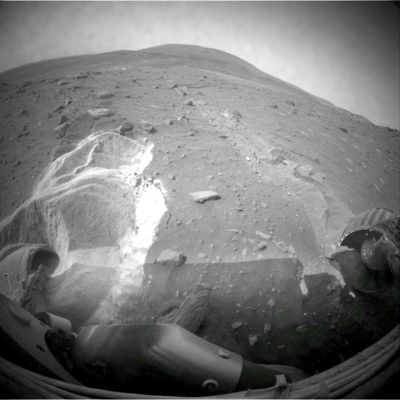Mars rover’s future in doubt

LOS ANGELES – Spirit has always been the unluckier of NASA’s twin Mars rovers.
Just weeks after landing in a Martian crater in 2004, it went haywire and transmitted gibberish to Earth. Engineers eventually nursed it back to health.
As if the near-death experience wasn’t enough, Spirit was upstaged early on by its twin Opportunity, which landed in a geologic gold mine and was the first to determine that the frigid, dusty planet possessed a wetter past.
Bad luck has fallen again on Spirit. As the workhorse rover marks its sixth year on the red planet on Sunday, it finds itself stuck in a sand trap, perhaps forever. The six-wheel robot geologist has been in jams before, but this is the worst yet.
With Martian winter arriving in several months, Spirit may not have enough power to keep going unless scientists can point the solar-powered rover toward the sun.
Spirit “has always been our drama queen,” chief scientist Steve Squyres of Cornell University said.
The latest misfortune occurred in April when Spirit, driving backward because of a lame wheel, broke through the crusty ground like a person falling through a frozen pond and became bogged in fluffy sand. Little progress has been made to free Spirit since.
NASA was dealt a major setback recently when another wheel appeared to have stopped moving, leaving Spirit with only four working wheels.
“With only four driving wheels, it doesn’t look good,” said project manager John Callas, of NASA’s Jet Propulsion Laboratory.
It’s been a particularly rough year for Spirit. Besides getting stuck in a sand rut, it suffered sporadic bouts of amnesia and other woes including sudden computer reboots.
Though the prognosis of getting Spirit out looks bleak, scientists are not ready to give up yet. But if they exhaust all escape options, they will switch to Plan B and try to tilt the rover to the north where it can get more sunshine to keep running so that it can continue to do science in one spot.
Fortunately for researchers, what may turn out to be Spirit’s final resting spot looks like a scientific bonanza. The sand is rich in sulfate, a mineral that forms in the presence of water, researchers say.
With Spirit immobile, it’s still snapping pictures of its surroundings and sending data back to Earth.